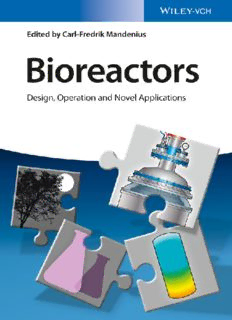
Bioreactors : design, operation and novel applications PDF
Preview Bioreactors : design, operation and novel applications
Editedby Carl-FredrikMandenius Bioreactors Editedby Carl-FredrikMandenius Bioreactors Design,OperationandNovelApplications Editor AllbookspublishedbyWiley-VCHare carefullyproduced.Nevertheless,authors, Prof.Carl-FredrikMandenius editors,andpublisherdonotwarrantthe LinköpingUniversity informationcontainedinthesebooks, DivisionofBiotechnology,IFM includingthisbook,tobefreeoferrors. 58183Linköping Readersareadvisedtokeepinmindthat Sweden statements,data,illustrations,procedural detailsorotheritemsmayinadvertently beinaccurate. LibraryofCongressCardNo.:appliedfor BritishLibraryCataloguing-in-Publication Data Acataloguerecordforthisbookis availablefromtheBritishLibrary. Bibliographicinformationpublishedby theDeutscheNationalbibliothek TheDeutscheNationalbibliothek liststhispublicationintheDeutsche Nationalbibliografie;detailed bibliographicdataareavailableonthe Internetat<http://dnb.d-nb.de>. ©2016Wiley-VCHVerlagGmbH&Co. KGaA,Boschstr.12,69469Weinheim, Germany Allrightsreserved(includingthoseof translationintootherlanguages).Nopart ofthisbookmaybereproducedinany form – byphotoprinting,microfilm, oranyothermeans – nortransmitted ortranslatedintoamachinelanguage withoutwrittenpermissionfromthe publishers.Registerednames,trademarks, etc.usedinthisbook,evenwhennot specificallymarkedassuch,arenottobe consideredunprotectedbylaw. PrintISBN:978-3-527-33768-2 ePDFISBN:978-3-527-68337-6 ePubISBN:978-3-527-68338-3 MobiISBN:978-3-527-68339-0 oBookISBN:978-3-527-68336-9 CoverDesign Formgeber,Mannheim, Germany Typesetting SPiGlobal,Chennai,India PrintingandBinding Printedonacid-freepaper V Contents Preface XV ListofContributors XVII 1 ChallengesforBioreactorDesignandOperation 1 Carl-FredrikMandenius 1.1 Introduction 1 1.2 BiotechnologyMilestoneswithImplicationsonBioreactor Design 2 1.3 GeneralFeaturesofBioreactorDesign 8 1.4 RecentTrendsinDesigningandOperatingBioreactors 12 1.5 TheSystemsBiologyApproach 17 1.6 UsingConceptualDesignMethodology 20 1.7 AnOutlookonChallengesforBioreactorDesignandOperation 29 References 32 2 DesignandOperationofMicrobioreactorSystemsforScreeningand ProcessDevelopment 35 ClemensLattermannandJochenBüchs 2.1 Introduction 35 2.2 KeyEngineeringParametersandPropertiesinMicrobioreactor DesignandOperation 36 2.2.1 SpecificPowerInput 37 2.2.2 Out-of-PhasePhenomena 40 2.2.3 MixinginMicrobioreactors 42 2.2.4 Gas–LiquidMassTransfer 44 2.2.4.1 InfluenceoftheReactorMaterial 47 2.2.4.2 InfluenceoftheViscosity 49 2.2.5 InfluenceofShearRates 50 2.2.6 VentilationinShakenMicrobioreactors 51 2.2.7 HydromechanicalStress 52 2.3 DesignofNovelStirredandBubbleAeratedMicrobioreactors 53 2.4 RoboticsforMicrobioreactors 54 2.5 Fed-BatchandContinuousOperationofMicrobioreactors 56 VI Contents 2.5.1 Diffusion-ControlledFeedingoftheMicrobioreactor 56 2.5.2 EnzymeControlledFeedingoftheMicrobioreactor 58 2.5.3 FeedingofContinuousMicrobioreactorsbyPumps 59 2.6 MonitoringandControlofMicrobioreactors 60 2.6.1 DOTandpHMeasurement 62 2.6.2 RespiratoryActivity 63 2.7 Conclusion 66 Terms 67 GreekLetters 68 DimensionlessNumbers 69 ListofAbbreviations 69 References 69 3 BioreactorsonaChip 77 DannyvanNoort 3.1 Introduction 77 3.2 AdvantagesofMicrosystems 79 3.2.1 ConcentrationGradients 81 3.3 ScalingDowntheBioreactortotheMicrofluidicFormat 82 3.4 MicrofabricationMethodsforBioreactors-On-A-Chip 82 3.4.1 EtchingofSilicon/Glass 83 3.4.2 SoftLithography 83 3.4.3 HotEmbossing 84 3.4.4 MechanicalFabricationTechnique(OrPoorMan’s Microfluidics) 84 3.4.5 LaserMachining 85 3.4.6 ThinMetalLayers 86 3.5 FabricationMaterials 86 3.5.1 InorganicMaterials 86 3.5.2 ElastomersandPlastics 87 3.5.2.1 Elastomers 87 3.5.2.2 Thermosets 87 3.5.2.3 Thermoplastics 87 3.5.3 Hydrogels 88 3.5.4 Paper 88 3.6 IntegratedSensorsforKeyBioreactorParameters 89 3.6.1 Temperature 89 3.6.2 pH 90 3.6.3 O 90 2 3.6.4 CO 90 2 3.6.5 CellConcentration(OD) 90 3.6.6 HumidityandEnvironmentStability 91 3.6.7 Oxygenation 91 3.7 ModelOrganismsAppliedtoBRoCs 91 3.8 ApplicationsofMicrofluidicBioreactorChip 92 Contents VII 3.8.1 AChemostatBRoC 92 3.8.2 UsingaBRoCasaSingle-CellChemostat 95 3.8.3 MammalianCellsintheBioreactoronaChip 96 3.8.4 Body-on-a-ChipBioreactors 98 3.8.5 Organ-on-a-ChipBioreactor-LikeApplications 99 3.9 ScaleUp 100 3.10 Conclusion 101 Abbreviations 102 References 103 4 ScalableManufactureforCellTherapyNeeds 113 QasimA.Rafiq,ThomasR.J.Heathman,KarenCoopman,AlvinW.Nienow, andChristopherJ.Hewitt 4.1 Introduction 113 4.2 RequirementsforCellTherapy 115 4.2.1 Quality 115 4.2.2 NumberofCellsRequired 117 4.2.3 Anchorage-DependentCells 118 4.3 StemCellTypesandProducts 119 4.4 ParadigmsinCellTherapyManufacture 120 4.4.1 Haplobank 121 4.4.2 AutologousProducts 121 4.4.3 AllogeneicProducts 123 4.5 CellTherapyManufacturingPlatforms 124 4.5.1 Scale-OutTechnology 125 4.5.2 Scale-UpTechnology 127 4.6 MicrocarriersandStirred-TankBioreactors 128 4.6.1 OverviewofStudiesUsingaStirred-TankBioreactorand MicrocarrierSystem 130 4.7 FutureTrendsforMicrocarrierCulture 136 4.8 PreservationofCellTherapyProducts 138 4.9 Conclusions 139 References 140 5 ArtificialLiverBioreactorDesign 147 KatrinZeilingerandJörgC.Gerlach 5.1 NeedforInnovativeLiverTherapies 147 5.2 RequirementstoLiverSupportSystems 147 5.3 BioreactorTechnologiesUsedinClinicalTrials 148 5.3.1 ArtificialLiverSupportSystems 148 5.3.2 BioartificialLiverSupportSystems 149 5.4 OptimizationofBioartificialLiverBioreactorDesigns 152 5.5 ImprovementofCellBiologyinBioartificialLivers 155 5.6 BioreactorsEnablingCellProductionforTransplantation 157 5.7 CellSourcesforBioartificialLiverBioreactors 158 VIII Contents 5.7.1 PrimaryLiverCells 158 5.7.2 HepaticCellLines 161 5.7.3 StemCells 161 5.8 Outlook 163 References 164 6 BioreactorsforExpansionofPluripotentStemCellsandTheir DifferentiationtoCardiacCells 175 RobertZweigerdt,BirgitAndree,ChristinaKropp,andHenningKempf 6.1 Introduction 175 6.1.1 RequirementforAdvancedCellTherapiesforHeartRepair 175 6.1.2 PluripotentStemCell–BasedStrategiesforHeartRepair 176 6.2 CultureTechnologiesforPluripotentStemCellExpansion 179 6.2.1 Matrix-DependentCultivationin2D 179 6.2.2 OutscalinghPSCProductionin2D 179 6.2.3 Hydrogel-SupportedTransitionto3D 182 6.3 3DSuspensionCulture 182 6.3.1 AdvantagesofUsingInstrumentedStirredTankBioreactors 182 6.3.2 ProcessInoculationandPassagingStrategies:CellClumpsVersus SingleCells 186 6.3.3 MicrocarriersorMatrix-FreeSuspensionCulture:Proand Contra 187 6.3.4 OptimizationandCurrentLimitationsofhPSCProcessinginStirred Bioreactors 188 6.4 AutologousVersusAllogeneicCellTherapies:Practicaland EconomicConsiderationsforhPSCProcessing 189 6.5 UpscalinghPSCCardiomyogenicDifferentiationinBioreactors 190 6.6 Conclusion 192 ListofAbbreviations 193 References 193 7 CulturingEntrappedStemCellsinContinuousBioreactors 201 RuiTostoesandPaulaM.Alves 7.1 Introduction 201 7.2 MaterialsUsedinStemCellEntrapment 202 7.3 SyntheticMaterials 203 7.3.1 Polymers 203 7.3.2 Peptides 207 7.3.3 Ceramic 208 7.4 NaturalMaterials 208 7.4.1 Proteins 208 7.4.2 Polysaccharides 209 7.4.3 Complex 211 7.5 ManufacturingandRegulatoryConstraints 212 7.6 MassTransferintheEntrapmentMaterial 214
